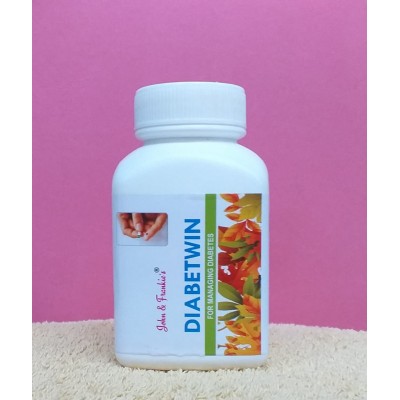DIABETWIN
DiabetWin 500mg capsules
Diabetes is a chronic disorder affecting the population on epidemic level. Diabetes results from abnormal metabolism of insulin wherein insulin action is impaired, or absolute insulin deficiency results in imbalance of glucose metabolism and leads to a syndrome called diabetes mellitus.The composition of Extracts of the following herbs made an effective Ayurvedic Medicine for well managing the diabetes. : The ingredients are :
Gymnema sylvestre is regarded as one of the plants with potent anti diabetic properties. This plant is also used for controlling obesity in the form of Gymnema tea. The active compound of the plant is a group of acids termed as gymnemic acids. It has been observed that there could be a possible link between obesity, Gymnemic acids and diabetes. It possesses antimicrobial, anti hypercholesterolemic, hepatoprotective and sweet suppressing activities.
Eugenia Jambolana, ( jambul ) fruit can be a particular medication for diabetes sufferers because of its effect on the pancreas. Jambul seeds include a glycoside, called jamboline that obstructs the transformation of starch into sugar in cases of elevated blood sugar levels. In the management of this ailment, the seeds, fruits and also fruit juice each are useful. Jambul seeds have been discovered to boost the insulin secretion from the pancreas. Additionally, it reduces the unappeasable thirst. To deal with diabetic issues, the interior bark of the jambul tree can also be used. The dried bark is burnt off and ash of it needs to be provided to diabetic patient on empty stomach along with water daily each morning, afternoon as well as in the night.
Emblica officinalis, known as Amla is a medicinal plant, used in Ayurveda for treating various diseases, one of which is diabetes mellitus. According to Ayurveda, amla balances all three doshas. Its effects on blood glucose in humans has been established. It has been used in a combination supplement (alongside Bitter Gourd, Gurmur) The aqueous extract of the seeds of Emblica officinalis was investigated for its anti-diabetic activity.
Trigonella Foenumgraceum, Known as Methika in Sanskrit and Ayurveda. This is another plant from the widely used family of Fabaceae / leguminosae – related to chickpeas and peanuts and when you look closely at these tiny seeds, Fenugreek is a herb that is widely used in cooking and as a traditional medicine for diabetes in Asia. A total of 10 trials were identified. Fenugreek significantly changed fasting blood glucose. The main action of fenugreek is as a digestive stimulant (Dipana), although it also has a specific action as a cardiac tonic and it pacifies Vata and Kapha.
Momoridica Charantia, also known as bitter milon. Bitter fruits are commonly used in cooking and as a natural remedy for treating diabetes. This plant has received the most attention for its anti-diabetic properties. Its fruit is used for the treatment of diabetes and related conditions amongst the indigenous populations of Asia, South America, India and East Africa. Abundant pre-clinical studies have documented in the anti-diabetic and hypoglycaemic effects of M. charantia through various postulated mechanisms.
Withania Somnifera, also known as Ashwagandha is an adaptogenic herb. Adaptogens are substances (a combination of amino acids, vitamins, and herbs).. Ashwagandha has long been used as a remedy for diabetes in Ayurvedic medicine. Research on the use of Ashwagandha in the treatment of diabetes indicated positive results. Experiments showed that blood sugar levels during fasting and post-lunch decreased significantly when Ashwagandha was consumed for a period of four weeks.
Azadirachta Indica, known as Neem. The pharmacological hypoglycemic action of Neem was examined. After 24 hrs treatment, Neem 250mg/kg, reduced glucose (15%), cholesterol (15%), triglycerides (32%). Urea (13%), creatinine (23%) and lipids (15%), Multiples dose study for 15 days also reduced creatinine, urea, lipids, triglycerides and glucose. In glucose tolerance test with neem extract 250mg/kg demonstrated glucose levels were significantly less compared to the control group. Azadirachta indica significantly reduce glucose levels at 15th day.




